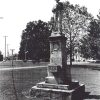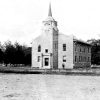calsfoundation@cals.org
Yell County Courthouse, Dardanelle Judicial District
The Yell County Courthouse for the Dardanelle Judicial District, governing the northern part of Yell County, is located on the west end of Union Street in Dardanelle (Yell County). The Arkansas River and the River Front Park are nearby, and the courthouse is surrounded by county buildings, historical markers and monuments, small businesses, and residential neighborhoods. The Arkansas Historic Preservation Program recognizes the courthouse as architecturally and historically significant to Yell County, as it stands as the best example of the Classical Revival style in the area. It was added to the National Register of Historic Places on September 8, 1992.
Timber—including cottonwood, gum, elm, sycamore, and ash—made up much of Dardanelle and Yell County’s economy. The city became a center of commerce in the 1870s, while attracting new residents from around the United States as well as Eastern European immigrants. As the population increased, the Arkansas General Assembly divided Yell County in 1875 and appointed Dardanelle as a county seat to serve alongside Danville (Yell County). The cities held separate chancery, circuit, and probate courts, while the county clerk maintained an office in both courthouses.
The Dardanelle Judicial District courthouse was occupied in 1878 and housed county affairs for the district. Details about its appearance are unknown. Many figures in Arkansas’s legal profession practiced there, including Associate Justice of the Arkansas Supreme Court Jesse Cleveland Hart, Judge William Dodge Jacoway of the Fifth Judicial Circuit, and Congressman Henderson Jacoway. A fire destroyed the building in 1913, and Yell County began planning to build a new one.
Yell County appropriated $25,000 for the project in April 1913, but a group of citizens protested the building of a new county courthouse. J. B. Law, who formerly served as county assessor and clerk for twelve years, led the protestors and filed a motion in county court to halt any construction. He argued that the burden of building a courthouse should fall to the people of the district and not the whole county. The judge denied Law’s petition and began an appeal process that ended at the Arkansas Supreme Court. The highest court in Arkansas ruled in favor of the county in Law v. Falls that October, and the new courthouse went up in 1914.
Frank W. Gibb, a prolific Arkansas architect, designed the two-story building in the Classical Revival Style, and the L. R. Wight and Company of Dallas, Texas, built it. A set of white Doric columns at the front contrasts with walls of red brick. Also featured are a pediment, a wide frieze, and a cupula dome atop the T-shaped courthouse. Changes have been made to the building over the years, including an extensive 1973 renovation. The Dardanelle Confederate Monument was installed in 1921, and the Dardanelle Garden Club moved a previously neglected war memorial to the courthouse grounds in 2011. Offices make up the first floor, and the courtroom is on the second. The remaining county services are provided in surrounding buildings.
In 1976, Yell County built a jail that stands behind the courthouse. In 2007, a 7,000-square-foot annex opened to accommodate a larger district court and to make county facilities compliant with the Americans with Disabilities Act.
For additional information:
Biographical and Historical Memoirs of Western Arkansas. Chicago: Goodspeed Publishing Co., 1891.
Cases Determined in the Supreme Court of Arkansas: From June, 1913 to October, 1913. Little Rock: Democrat Printing & Lithographic Company, 1914.
“Dardanelle Confederate Monument.” National Register of Historic Places nomination form. On file at Arkansas Historic Preservation Program, Little Rock, Arkansas. Online at http://www.arkansaspreservation.com/National-Register-Listings/PDF/YE0064S.nr.pdf (accessed December 20, 2019).
Gill, John Purifoy, and Marjem Jackson Gill. On the Courthouse Square in Arkansas. N.p.: 1980.
“Yell County Courthouse.” National Register of Historic Places nomination form. On file at Arkansas Historic Preservation Program, Little Rock, Arkansas. Online at http://www.arkansaspreservation.com/National-Register-Listings/PDF/YE0025.nr.pdf (accessed December 20, 2019).
Jared Craig
Arkansas Historic Preservation Program
 Dardanelle Confederate Monument
Dardanelle Confederate Monument Early Twentieth Century, 1901 through 1940
Early Twentieth Century, 1901 through 1940 Gibb, Frank Wooster
Gibb, Frank Wooster Historic Preservation
Historic Preservation Dardanelle Confederate Monument
Dardanelle Confederate Monument  Yell County Courthouse
Yell County Courthouse 




Comments
No comments on this entry yet.